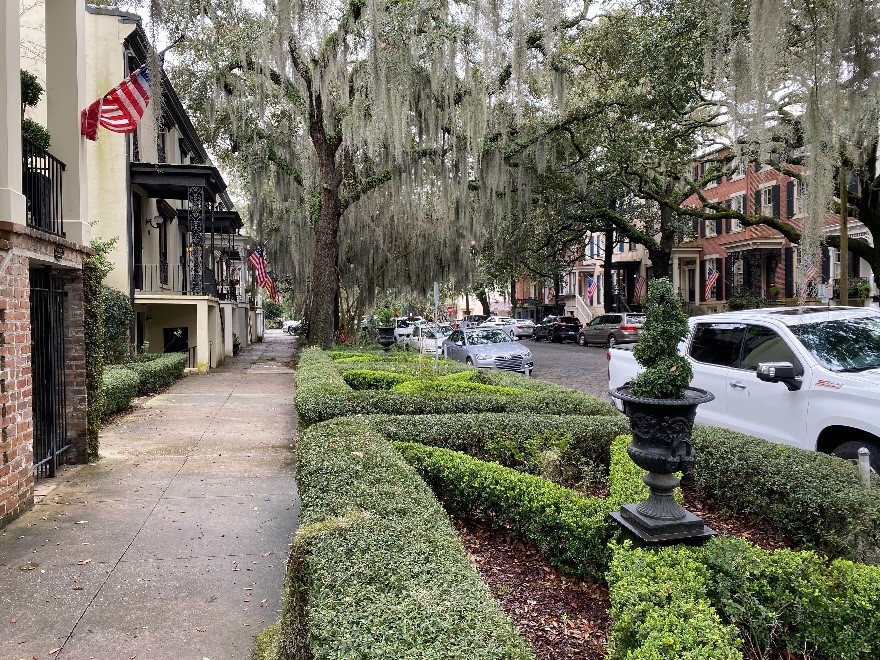SAVANNAH, GA: Until Union victory in the Civil War, the southern ports of Savannah in Georgia and Charleston in South Carolina were infamously linked to the African slave trade. Forty percent of all slaves arriving in the US passed through Charleston, a lovely city laid out by English colonists in 1670. Savannah, 100 miles south, was settled later and didn’t become a slave trading centre until 1750 when Georgia lifted its ban on slavery.
Prior to the millennium local tourism minimized slavery, stressing instead southern gentility, the charm of antebellum homes, the beauty of live oak trees, and Civil War sites. No more. Today’s visitors get a more balanced portrait of good and evil, an honest presentation of the cities’ complicated, shameful legacies.

Each city has about 150 000 inhabitants and both have registered huge progress in improving people’s lives. Charleston is 73% white, Savannah 53% black. Savannah elected its first black mayor in 1995. Today a black mayor presides over a black majority city council. The school superintendent, police chief, county commission chief, and university president are all black.
After America’s free trade deal with Mexico – the North American Free Trade Area (NAFTA) – in 1994 and the accession of China into the World Trade Organization, the decline of the southern textile industry accelerated. Enlightened leadership in both cities actively sought investment. The game plan included tax incentives, emphasis on relatively low wages, a skilled work force, and opposition to trade unions. The results have been spectacular.
Today, Savannah’s once sleepy economy is 25% industrial with Gulfstream Aerospace, which builds the world’s most popular corporate jet, being the largest employer. Charleston has been even more successful. Boeing came to the city in 2009 with what is now a US$2 billion investment in a plant employing 7 000 workers, building the 787 Dreamliner.
More recently Charleston won a US$500 million investment from Mercedes for a greenfield plant that builds its Sprinter cargo van. And since 2018 some 1 500 workers at a new Volvo plant near Charleston have been cranking out S60 sedans, many of which are exported. Volvo is owned by China’s Geely. Georgia also boasts a new auto plant, a large Kia facility west of Atlanta. For six years running Georgia has been ranked the best US state for business, followed by Tennessee and South Carolina.
Auto jobs pack a significant multiplier. A University of Charleston study finds that for every auto job created an additional four are generated for local suppliers and services. Indian-American Nikki Haley, South Carolina’s Republican governor from 2011 to 2017, was tireless in bringing foreign investors to South Carolina. She was also a fierce opponent of unions, famously telling prospective investors that South Carolina was proud of its reputation ‘for being a state that doesn’t want unions.’
It was BMW’s 1995 decision to build cars in Spartanburg, 200 miles inland from Charleston, that sparked the South Carolina industrial renaissance. That facility, now an US$11 billion investment, is the German company’s biggest factory. It employs 11 000 workers producing 400 000 cars a year. Seventy percent of output is exported, making BMW America’s biggest car exporter. Most exports go through the ports of Savannah and Charleston.
Savannah handles more containers than Charleston and is the 4th biggest US container port. Both have deep water channels accommodating the biggest container ships. Both are modern, efficient, and fast-growing.

An important third element to success is tourism. Savannah attracted 14 million visitors in 2019. In addition to local attractions, both cities benefit from close proximity to ocean beaches at Hilton Head and Myrtle Beach.


Both cities were central to the 1861-65 war between the states. Hostilities began in Charleston after South Carolina secessionists seized Fort Sumter in Charleston harbour. The war neared its end after the Union general, William Tecumseh Sherman, finished his march through Georgia in Savannah, famously presenting the city to President Lincoln as a Christmas present.
Today instead of refighting the Civil War and its legacy, Savannah and Charleston have moved on, putting the livelihoods of people first.
The views of the writer are not necessarily the views of the Daily Friend or the IRR
If you like what you have just read, support the Daily Friend

